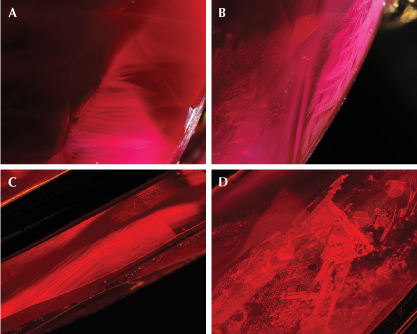Natural-Looking Inclusions in a Ramaura Synthetic Ruby

GIA’s Tokyo laboratory recently observed a vivid red stone mounted in a ring that was submitted for an identification and origin report. This stone measured 14.13 × 5.41 × 3.60 mm, with an estimated weight around 2.14 ct. It showed two strong specific absorption lines around 468 and 476 nm in the blue area through a handheld spectroscope, and its gemological properties confirmed ruby.
The ruby fluoresced strong red to long- and short-wave ultraviolet light. It contained natural-looking angular milky clouds (figure 1A), unusual wispy veil-like milky clouds (figure 1B), strong angular graining (figure 1C), and triangular negative crystals containing flux-like materials and minute bubbles (figure 1D). Although the pattern of milky clouds gave the appearance of a natural origin, the wispy veil-like clouds and triangular flux-like inclusions are characteristics of flux-grown synthetic ruby.

Laser ablation–inductively coupled plasma–mass spectrometry (LA-ICP-MS) was used to determine the chemical nature of the stone. The analysis revealed lower concentrations of magnesium and gallium and much higher concentrations of lanthanum, platinum, and lead than those found in natural rubies (table 1). Vanadium was not detected. These chemical features, especially the absence of vanadium and the detection of lanthanum, platinum, and lead, were abnormal for natural ruby. The inclusions and trace element chemistry, particularly the presence of lanthanum, suggested a Ramaura flux-grown synthetic ruby (e.g., S. Muhlmeister et al., “Separating natural and synthetic rubies on the basis of trace-element chemistry,” Summer 1998 G&G, pp. 80–101). The inclusions were consistent with those in Ramaura flux-grown rubies except for the presence of natural-looking milky clouds (R.E. Kane, “The Ramaura synthetic ruby,” Fall 1983 G&G, pp. 130–148).
The Ramaura flux process, first reported in 1983, can produce red corundum by spontaneous nucleation of a crystal from a high-temperature flux. Ramaura synthetic rubies are formed using a flux of Bi2O3 and PbF2 within a platinum crucible (Muhlmeister et al., 1998). The La2O3 is intentionally added to the flux, and thus the presence of lanthanum is a specific signature of Ramaura synthetic ruby. Most of this stone’s inclusions and chemical features supported a synthetic origin, but the natural-looking milky inclusions were unusual and have not been reported until now.

In order to clarify the cause of the natural-looking clouds, LA-ICP-MS results from the clean areas and the cloudy areas reaching the girdle were compared (figure 2). The chemical comparison suggested that the cloudy area was extremely rich in lanthanum and lead relative to the clean area (table 1). How lanthanum and lead are incorporated into this synthetic ruby is not clear, as there were no obvious inclusions that could be tested (such as particles or flakes within the clouds). However, the natural-looking clouds were clearly formed by partial enrichment of lanthanum and lead within this Ramaura synthetic ruby.
Surprisingly, such milky clouds and flux inclusions could be confused with heated natural ruby and might cause misidentification. Careful observation of inclusions in the stone and chemical analysis were both needed to confirm that this was a laboratory-grown ruby.
.jpg)


